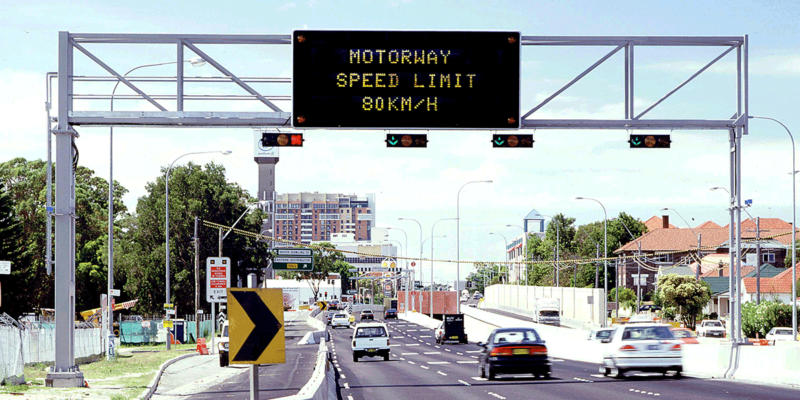Connecting our land of sweeping plains, Australia’s National Land Transport Network comprises approximately 21,000 km of highways. With Highway 1 being the longest national highway in the world at 14,500 km.

These vast distances and associated high speeds often result in an unfortunate crash history, where more than 100 Australians die on our roads every month and over 2,500 are seriously injured.
Situational Awareness
A motorist will approach a situation or hazard on a highway much faster than in suburbia. For this reason, situational awareness of what will soon be encountered is increasingly important, to prepare the motorist to take appropriate preventative action. This may include rapid braking, slowing down or just keeping a look out for hazards, in the hope of reducing the risk of rear-end collisions. For example, in the situation arising from a vehicle breakdown.
“If only we knew what was ahead,
we could have taken appropriate action to avoid…”
Although collision avoidance is of utmost importance, there is also value in assisting motorists with awareness in relation to all types of hazards. Such as livestock, snow, ice, oil slicks, debris and more. Awareness that can be initiated through the relaying of information provided by either a person reporting a situation or through automatic incident detection.
Incident Detection
Detection of a hazard thus provides the necessary trigger for taking any preventative action or co-ordinating a response. Including motorists avoiding the incident, mechanical assistance and emergency services. While CCTV can provide visual awareness, integrated automatic incident detection (AID) can reduce the mean time to detect (MTTD) and dramatically reduce emergency vehicle response times (EVRT). In view of the vast expanse of Australia’s highways, this is of critical importance. As data has demonstrated that rural collisions with crash notification times greater than 30 minutes, were more likely to result in a fatality than collisions in the urban environment[1].

Detection Solutions
A range of intelligent traffic detection solutions are available that are suitable for use on Australia’s highways, up to withstanding a variety of harsh environmental conditions. In addition to a weatherproof camera, other add-ons can include the integration of solar power, 3G/4G connectivity. At the next level, the integration of automatic incident detection (AID), thermal imaging capability and edge technology; for example the FLIR ITS-Series Dual AID, can provide superior situational awareness with integration of both visual and thermal cameras. Seeing regardless of weather conditions and environmental hazards such as smoke.
Hazard Notification
Variable Message Signs (VMS) are a key component in any comprehensive traffic management system[2]. Where messages have to be luminous and large enough to be read at a considerable distance. Whilst also providing adequate legibility, particularly for older drivers and in adverse weather conditions. Regarding weather, a study on weather-controlled variable speed limit systems that are based on automatic classification of road conditions, resulted in an injury accident risk decrease of 13% in winter[3].

Notification Variations
Additionally, when not notifying of a hazardous situation, the variable message sign can be utilised to display useful information such as trip data, for example time to destination or expected delays[4]. Alternatively, community messaging, civil alerts and speed information can also be displayed as required.
Enhancing Awareness across Australia
Due to the long stretches of uninhabited highways that connect the Australian outback, rural collisions may result in longer crash notification times[5]. However, once emergency services become aware of a situation, a digital link to the VMS can provide awareness to approaching motorists to either prepare for or avoid the situation altogether. Armitage Group has provided variable message signs and sensors to various highways and roads across Australia, keeping motorists informed and helping reduce emergency response times.
Some examples include:
NSW – Eastern Distributor, M4 Western Motorway, NorthConnex, WestConnex, Sydney Airport
QLD – Pacific Highway, Gold Coast, Brisbane City, Inner City Bypass
VIC – Melbourne Airport, Melbourne CBD
SA – Torens2Torens, Obahn, Darlington, Northern Connector, Superway
WA – Kiwnana Highway, Graham Farmers Freeway, Northbridge, Pinga
TAS – Hobart City
Over the Horizon
As advances have been made, the inclusion of automatic incident detection (AID) and edge technology has been integrated, for example in countries such as Belgium, placing them at the forefront of incident detection and motorist notification. This has enabled faster response times, contributing to the lowering of the highway accident mortality rate[6].
As can be seen, through early and/or automated incident detection and integrated variable messaging systems, the frequency of highway accidents and associated mortality rate can hopefully be decreased. In the future, technology like V2X will provide even faster notification, internal to the motorist’s vehicle. Although this may be true, external detection and notification remain integral components in an interconnected highway intelligent traffic management system.
[1]Plevin, R., Kaufman, R., Fraade-Blanar, L., & Bulger, E. (2017). Evaluating the Potential Benefits of Advanced Automatic Crash Notification. Prehospital and Disaster Medicine, 32(2), 156-164.
[2]Peng, Z.R., Guequierre, N. and Blakeman, J.C., 2004. Motorist response to arterial variable message signs. Transportation research record, 1899(1), pp.55-63.
[3]Rama, P. and Schirokoff, A., 2004. Effects of weather-controlled variable speed limits on injury accidents. In European Congress on Intelligent Transportation Systems and Services, 4th, 2004, Budapest, Hungary.
[4]Richard, T.A.Y. and De Barros, A., 2010. Effectiveness of road safety messages on variable message signs. Journal of Transportation Systems Engineering and Information Technology, 10(3), pp.18-23.
[5]Lahausse, J.A., Fildes, B.N., Page, Y. and Fitzharris, M.P., 2008. The potential for automatic crash notification systems to reduce road fatalities. In Annals of Advances in Automotive Medicine/Annual Scientific Conference (Vol. 52, p. 85). Association for the Advancement of Automotive Medicine.
[6]Wu, J., Subramanian, R., Craig, M., Starnes, M. and Longthorne, A., 2013. The effect of earlier or automatic collision notification on traffic mortality by survival analysis. Traffic injury prevention, 14(sup1), pp.S50-S57.

